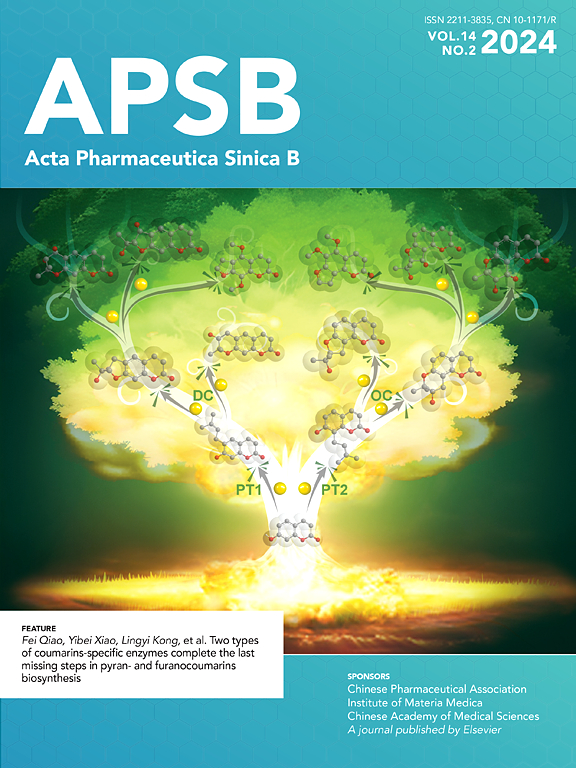Parabacteroides distasonis promotes liver regeneration by increasing β-hydroxybutyric acid (BHB) production and BHB-driven STAT3 signals
IF 14.7
1区 医学
Q1 PHARMACOLOGY & PHARMACY
引用次数: 0
Abstract
The liver regenerative capacity is crucial for patients with end-stage liver disease following partial hepatectomy (PHx). The specific bacteria and mechanisms regulating liver regeneration post-PHx remain unclear. This study demonstrated dynamic changes in the abundance of Parabacteroides distasonis (P. distasonis) post-PHx, correlating with hepatocyte proliferation. Treatment with live P. distasonis significantly promoted hepatocyte proliferation and liver regeneration after PHx. Targeted metabolomics revealed a significant positive correlation between P. distasonis and β-hydroxybutyric acid (BHB), as well as hyodeoxycholic acid and 3-hydroxyphenylacetic acid in the gut after PHx. Notably, treatment with BHB, but not hyodeoxycholic acid or 3-hydroxyphenylacetic acid, significantly promoted hepatocyte proliferation and liver regeneration in mice after PHx. Moreover, STAT3 inhibitor Stattic attenuated the promotive effects of BHB on cell proliferation and liver regeneration both in vitro and in vivo. Mechanistically, P. distasonis upregulated the expression of fatty acid oxidation-related proteins, and increased BHB levels in the liver, and then BHB activated the STAT3 signaling pathway to promote liver regeneration. This study, for the first time, identifies the involvement of P. distasonis and its associated metabolite BHB in promoting liver regeneration after PHx, providing new insights for considering P. distasonis and BHB as potential strategies for promoting hepatic regeneration.

副芽孢杆菌通过增加β-羟基丁酸(BHB)的产生和BHB驱动的STAT3信号来促进肝脏再生
肝脏再生能力对于部分肝切除术(PHx)后终末期肝病患者至关重要。phx后调节肝脏再生的具体细菌和机制尚不清楚。本研究证实phx后异裂副杆菌(P. distasonis)丰度的动态变化与肝细胞增殖相关。用活的distasonis治疗可显著促进PHx术后肝细胞增殖和肝再生。靶向代谢组学显示,PHx后肠内P. distasonis与β-羟基丁酸(BHB)、羟脱氧胆酸和3-羟基苯基乙酸呈显著正相关。值得注意的是,用BHB,而不是羟基去氧胆酸或3-羟基苯基乙酸,显著促进PHx小鼠肝细胞增殖和肝脏再生。此外,STAT3抑制剂statstatic在体外和体内均减弱了BHB对细胞增殖和肝脏再生的促进作用。机制上,P. distasonis上调脂肪酸氧化相关蛋白的表达,使肝脏BHB水平升高,BHB激活STAT3信号通路,促进肝脏再生。本研究首次确定了P. distasonis及其相关代谢物BHB在PHx后促进肝脏再生中的作用,为考虑P. distasonis和BHB作为促进肝脏再生的潜在策略提供了新的见解。
本文章由计算机程序翻译,如有差异,请以英文原文为准。
求助全文
约1分钟内获得全文
求助全文
来源期刊

Acta Pharmaceutica Sinica. B
Pharmacology, Toxicology and Pharmaceutics-General Pharmacology, Toxicology and Pharmaceutics
CiteScore
22.40
自引率
5.50%
发文量
1051
审稿时长
19 weeks
期刊介绍:
The Journal of the Institute of Materia Medica, Chinese Academy of Medical Sciences, and the Chinese Pharmaceutical Association oversees the peer review process for Acta Pharmaceutica Sinica. B (APSB).
Published monthly in English, APSB is dedicated to disseminating significant original research articles, rapid communications, and high-quality reviews that highlight recent advances across various pharmaceutical sciences domains. These encompass pharmacology, pharmaceutics, medicinal chemistry, natural products, pharmacognosy, pharmaceutical analysis, and pharmacokinetics.
A part of the Acta Pharmaceutica Sinica series, established in 1953 and indexed in prominent databases like Chemical Abstracts, Index Medicus, SciFinder Scholar, Biological Abstracts, International Pharmaceutical Abstracts, Cambridge Scientific Abstracts, and Current Bibliography on Science and Technology, APSB is sponsored by the Institute of Materia Medica, Chinese Academy of Medical Sciences, and the Chinese Pharmaceutical Association. Its production and hosting are facilitated by Elsevier B.V. This collaborative effort ensures APSB's commitment to delivering valuable contributions to the pharmaceutical sciences community.
 求助内容:
求助内容: 应助结果提醒方式:
应助结果提醒方式:


